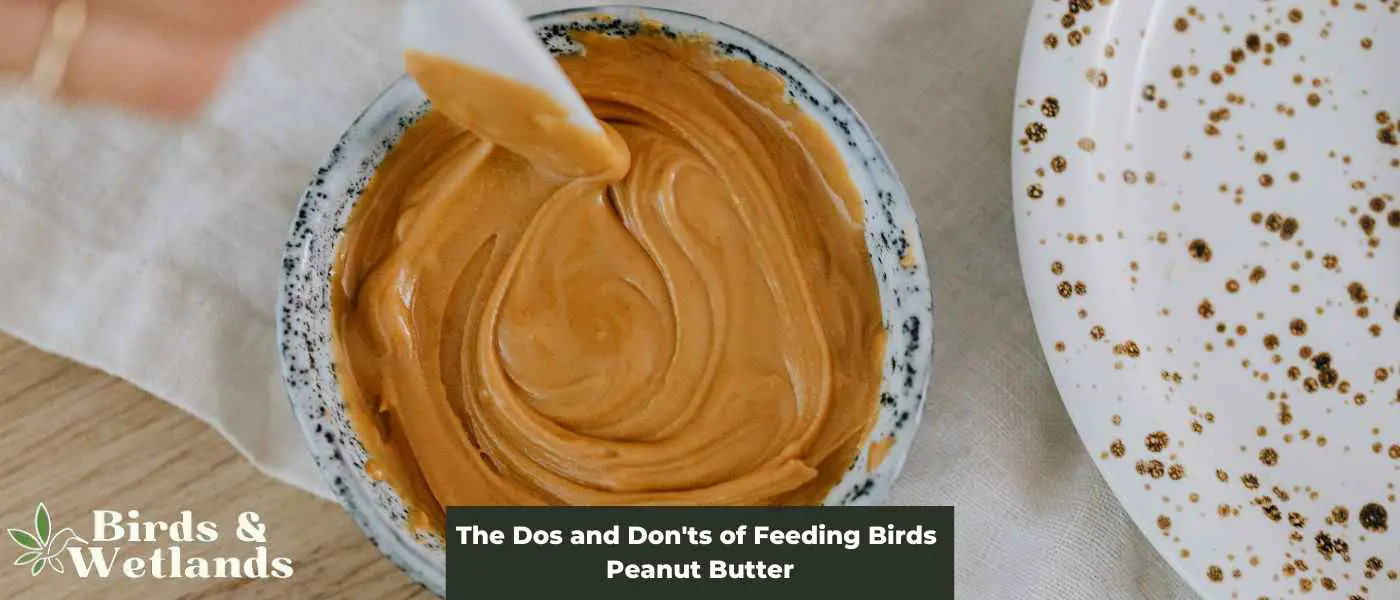Feeding birds peanut butter can be a beneficial supplement to their diet as it’s rich in fats and proteins. You can smear it on tree trunks, a pine cone, or specially designed peanut butter bird feeders. However, it’s essential to use unsalted and unsweetened varieties, as salt and sugar can be harmful to birds. In cold weather, you can mix peanut butter with cornmeal or oats to prevent it from becoming too sticky, which could potentially cause choking.
Key Takeaways on Feeding Peanut Butter to Birds
Can birds eat peanut butter?
Yes, birds can eat peanut butter. They have beaks and tongues that make eating peanut butter easy.
However, it’s important to do so in moderation and with certain precautions. Peanut butter is a high-energy food that contains a lot of protein and fat, which can provide birds with a valuable source of nutrition, especially during the winter when natural food sources may be scarce.
However, it’s important to avoid giving birds peanut butter that contains added salt, sugar, or other ingredients that could be harmful to them. It’s best to avoid using peanut butter as the sole source of nutrition for birds, as they require a varied diet that includes seeds, fruits, and insects to stay healthy.
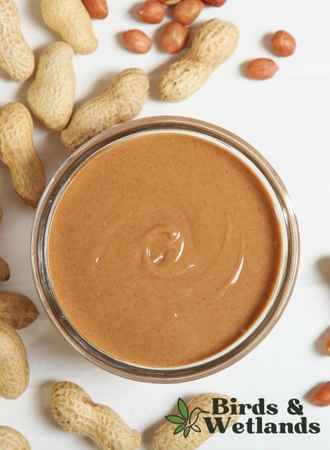
Is peanut butter good for birds?
While there are many types of bird feeders and bird food to choose from, peanut butter is a great addition to the menu. Here are some of the benefits of feeding birds peanut butter:
First and foremost, peanut butter is high in calories and protein, which is essential for birds, especially during the winter months when food is scarce. It can provide birds with the energy they need to stay warm and active, while also helping them maintain a healthy weight.
Peanut butter is also a good source of healthy fats, which are important for the growth and development of feathers, and for overall health. Peanut butter contains important vitamins and minerals, such as vitamin E and magnesium, which can support the immune system and keep birds healthy.
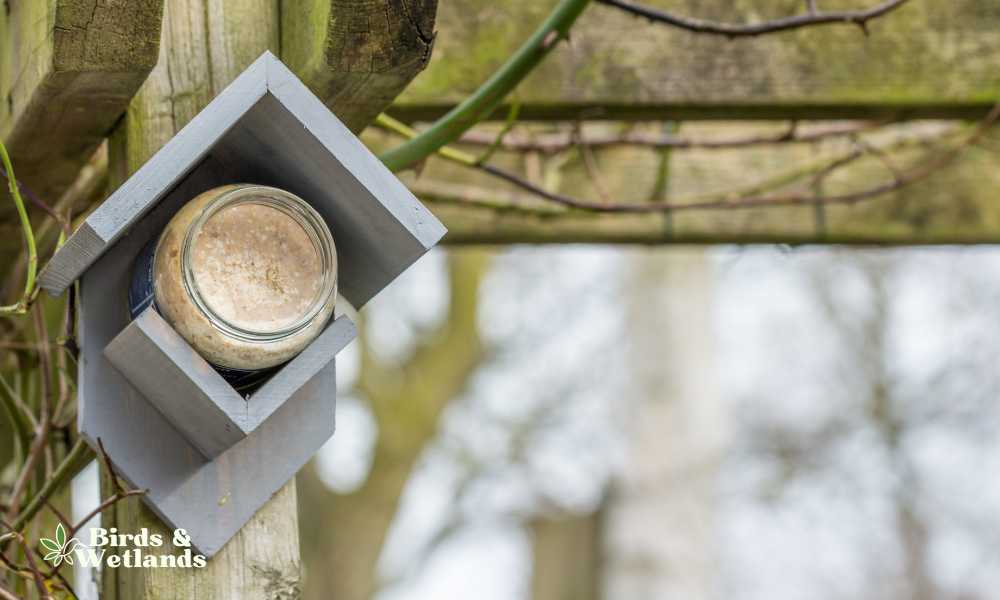
The best time to feed birds peanut butter is during the colder months when food is scarce, as this is when hungry birds need the extra calories and protein the most.
However, it’s important to remember that peanut butter should be offered as a supplement to a bird’s natural diet, not as a replacement for it. A varied diet is essential for the overall health of birds.
While peanut butter can be a great addition to a bird’s diet, there are also times when it should not be offered. During the summer months, for example, when insects and other food sources are abundant, birds may not need the extra calories and protein provided by peanut butter. If peanut butter is offered too frequently or in large quantities, it can lead to obesity and other health issues in birds.
How to feed peanut butter to birds
there are a few things to keep in mind when feeding peanut butter to birds to ensure it’s safe and beneficial for them.
Materials:
- Unsweetened and unsalted peanut butter
- Birdseed
- A pinecone, small log, or a commercial suet feeder
- String or wire (if using a pinecone or log)
Steps:
- Choose the Right Peanut Butter: It’s crucial to use unsalted and unsweetened peanut butter. Many commercial peanut butters contain a lot of added salt, sugar, or other ingredients that are not healthy for birds.
- Prepare the Feeder: If you’re using a pinecone or small log, tie a string or wire around it securely so you can hang it later. If you’re using a commercial suet feeder, make sure it’s clean and ready for use.
- Spread the Peanut Butter: Use a knife or spoon to spread the peanut butter onto the pinecone, log, or into the holes of the suet feeder. Make sure to get it into all the crevices.
- Roll in Birdseed (Optional): If you’d like, you can then roll the peanut butter-covered pinecone or log in birdseed. This will give the birds a variety of food options and can help attract different species.
- Hang Your Feeder: Hang your peanut butter feeder outside in a quiet, safe place. Near a window can be a good choice so you can enjoy watching the birds come to feed.
Remember to replace the peanut butter regularly to ensure it stays fresh and safe for the birds. During hot weather, peanut butter can spoil or melt, so it’s best to provide it in small amounts or opt for different foods during the summer months. As always, also make sure to clean your feeders regularly to prevent disease transmission.
Squirrel Proof Peanut Butter Feeder
The Clever Choice for Bird Lovers
- Squirrel Protection: Designed to deter squirrels from accessing bird food, helping to conserve food for your feathered friends.
- Bird Safety: Helps protect feeding birds from larger predatory birds, offering a safer feeding environment.
- Hassle-Free Setup: No assembly required, providing a straightforward and user-friendly experience.
Can birds eat crunchy peanut butter blends?
Yes, birds can eat crunchy peanut butter. Peanut butter is a high-energy food source for many bird species, and the crunchy variety is no exception.
However, it is important to make sure that the peanut butter does not contain any additives, such as sugar or salt, which can be harmful to birds.
When offering peanut butter to birds, it is best to avoid spreading it directly on bread or crackers, as this can increase the risk of choking.

Can birds eat peanut butter crackers?
Peanut butter crackers are not a good choice to offer birds, regardless of how much peanut butter is in them. This is because crackers are typically made with processed flour, added salt, and other additives that are not part of a bird’s natural diet. These additives can have negative effects on a bird’s health.
For example, excess salt can lead to dehydration, which can be particularly harmful to birds in hot and dry weather. Many crackers are made with high amounts of sugar or artificial sweeteners, which can contribute to obesity and other health problems in birds over time.
Moreover, regular peanut butter crackers can also pose a choking hazard to birds, particularly if they are not crumbled or broken into small pieces. Larger chunks of crackers can get stuck in a bird’s throat, leading to respiratory problems and even death.
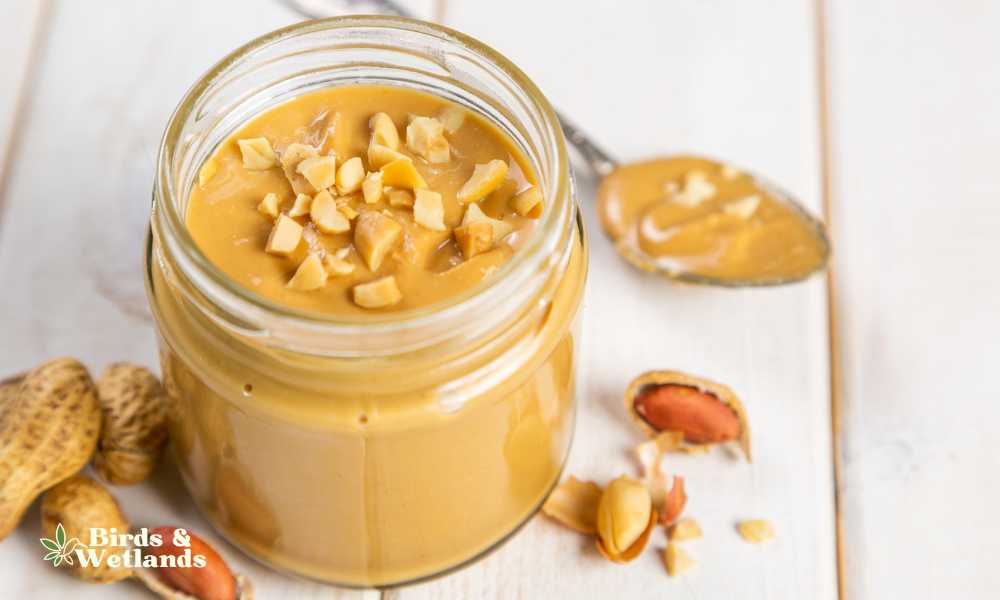
While birds may be attracted to the smell and taste of peanut butter cookies, it’s not a recommended food to offer to them. Peanut butter cookies often contain high amounts of sugar, flour, vegetable oil and extra ingredients that are not part of a bird’s natural diet.
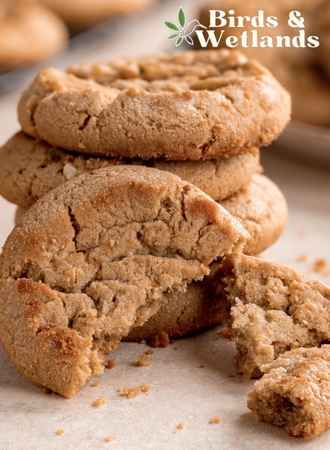
Do birds like peanut butter?
The answer to whether birds like peanut butter is not straightforward, as it depends on the specific bird species in question. While some birds enjoy consuming peanut butter, others may not be able to digest it, and it may even be harmful to their health.
Certain bird species, such as nuthatches, chickadees, blue jays, woodpeckers and other smaller birds eat peanuts and enjoy a delicious treat of peanut butter. These birds are primarily insectivores and are attracted to the high-fat content of peanut butter, which provides them with a valuable energy source.
However, other bird species, such as waterfowl, do not usually consume nuts or seeds in their natural diet and may not be able to digest peanut butter properly. Ingesting large quantities of peanut butter can cause blockages in their digestive system, leading to health problems.
How to feed birds peanut butter?
Offering birds peanut butter is a great way to attract them to your yard and provide them with a tasty, protein-rich treat. However, it’s important to follow some guidelines to make sure you are offering peanut butter in a safe and healthy way for the birds.
Firstly, it’s important to choose the right kind of peanut butter. Opt for all-natural, unsalted peanut butters made from roasted peanuts and do not contain any added sugar, salt, or other additives. These ingredients can be harmful to most birds and may also attract unwanted pests, such as ants and rodents. The peanut butter should be safe for human consumption as well.
Organic peanut butter which has the fewest additives is the best peanut butter for birds. If organic peanut butter is not available at your local grocery stores, you can make your own homemade peanut butters.
Once you have selected the peanut butter, you can offer it to the birds in a variety of ways. One popular method is to spread it onto a pine cone then roll it until it is covered in bird seed or corn and set the good mix on a wax paper. This allows them to peck at the peanut butter and extract small amounts at a time.
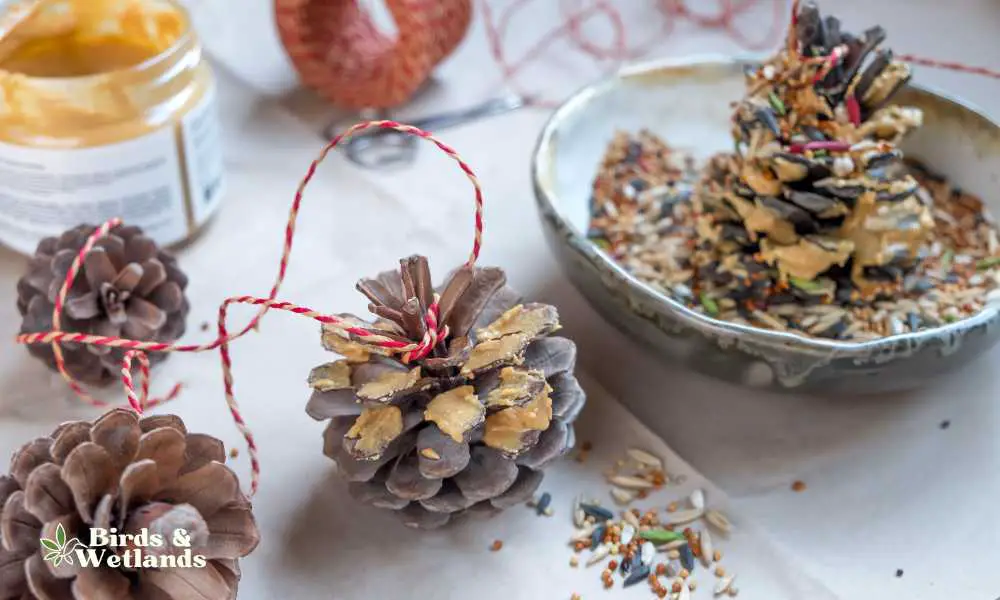
Another option is to smear a small amount of peanut butter onto a bird feeder or a shallow dish. You can even mix it with bird seed such as black oil sunflower seeds. This can be particularly effective for attracting birds that prefer to feed on the ground, such as juncos and sparrows.
It is important to thoroughly clean out a log-type feeder before refilling it if you plan to offer peanut butter stuffed into holes. This will help ensure the feeder is safe and healthy for the birds that will be feeding from it
Monitor the peanut butter in the suet cage and remove any uneaten portions after a few hours. This will help prevent spoilage and also discourage birds from becoming too dependent on the peanut butter as a food source. If allergy is a concern, you can always swap peanut butter for almond butter.
Wild Bird Copper Suet Feeder
A Must-Have for Bird Lovers
- Triple Capacity: Hold up to 3 cakes or a large brick for continuous bird feeding.
- User-Friendly: The EZ Fill design ensures effortless reloading of bird feed.
- Weather-Proof: Its unique roof design keeps feed dry, ensuring birds can feast in any weather.
- Comfort-First Design: The vinyl coating prevents birds’ feet from freezing in winter or burning in summer.
Always keep your feeders clean and don’t place them under direct sunlight. Hang them on trees or put them on a stick to attract nuthatches and other birds. If you’re worried about birds choking, you can mix peanut butter with cornmeal or fruit but never add salt.
While peanut butter is a nutritious food and a great treat, it should only be offered as a supplement to a bird’s regular diet. Many birds require a varied diet that includes a mix of seeds, fruits, insects, and other natural foods.
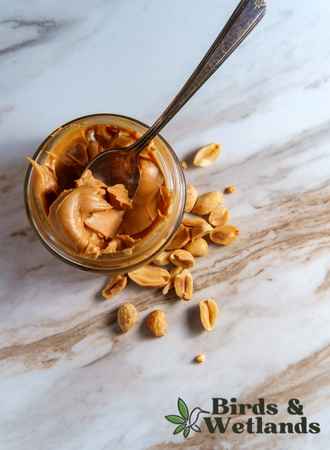
Best peanut butter for birds
The best peanut butter for birds is a natural, unsweetened, and unsalted variety. Many commercial brands of peanut butter contain added sugar, salt, or preservatives, which can be harmful to birds. Organic, raw peanut butter is an excellent choice as it typically contains just peanuts without any additives. Alternatively, some pet shops or wildlife stores sell specially formulated bird peanut butter, which is safe and nutritious for birds.
Peanut butter and oats for birds
Peanut butter and oats can provide a nutritious, high-energy food source for birds, particularly during the colder months. Here’s a simple recipe for a homemade bird treat using these ingredients.
Ingredients:
- 1 cup unsalted, unsweetened peanut butter
- 1 cup oats (old-fashioned oats are best)
- 1/4 cup birdseed (optional)
Materials:
- Mixing bowl
- Spoon or spatula
- Pinecones, small logs with holes drilled in, or a commercial suet feeder
- String or wire (if using a pinecone or log)
Steps:
- Mix the Ingredients: In a bowl, mix together the peanut butter and oats until well combined. If you’re using birdseed, mix that in as well.
- Prepare the Feeder: If you’re using a pinecone or a small log, tie a string or wire around it securely so you can hang it later. If you’re using a commercial suet feeder, make sure it’s clean and ready to use.
- Spread the Mixture: Use a spoon or spatula to spread the peanut butter-oat mixture onto your pinecone, log, or into the holes of your suet feeder. Make sure to get it into all the crevices.
- Hang Your Feeder: Hang your feeder outside in a safe, quiet spot. Near a window can be a good choice so you can enjoy watching the birds come to feed.

